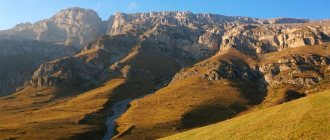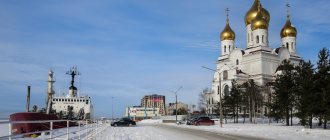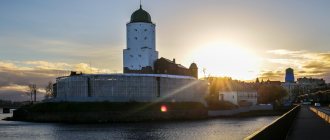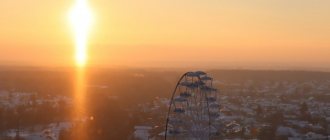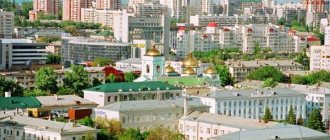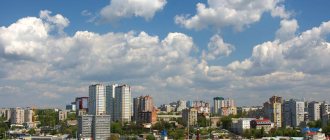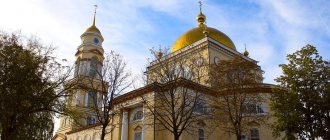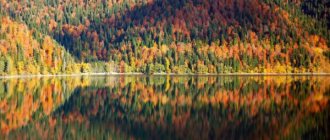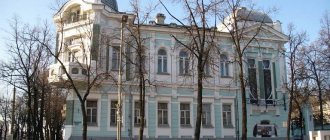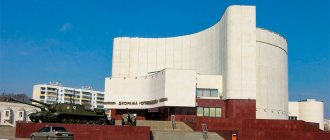The city of Velikiye Luki turned out to be very ancient, because the date of its foundation is considered to be 1166, as evidenced by numerous photos and attractions that have been attracting visitors for decades. This ordinary provincial city has something to please, because it has a great history, and besides, in ancient times it was called the “atrium of Moscow.”
Today I’ll tell you about what’s worth seeing in Velikiye Luki and where to spend a family vacation.
Obelisk of Glory
On the ramparts of the old fortress near the Lovat River there is a tall stone memorial obelisk about the fallen Soviet soldiers who defended the approaches to the city. At the base of the monument there is a capsule containing the ashes of an unknown soldier. Next to the stele are the mass graves of the multinational Soviet army.
The best natural attractions in Velikiye Luki
Dyatlinka Island
Rating: 5.0
The main natural attraction of Velikiye Luki is located in the branches of the Lovat River. This is Dyatlinka Island - a small artificial embankment, its origin remains unknown until now. However, a number of signs indicate that it was created by human hands.
On the territory of the island there are several park areas where many citizens with children relax. In addition, the artificial island is home to a sports complex where various competitions are held. And to access the island attraction you will need to cross the river via a suspension bridge. We can say that Dyatlinka is one of the calling cards of the city.
Monument to Alexander Matrosov
In 1948, the remains of the hero were transported from the village of Chernushok, where Alexander Matrosov died. Few people know that the guy who covered the enemy bunker with his body was only twelve years old. The monument at the grave of the young hero was opened in 1954.
Stele "City of Military Glory"
By order of the President of Russia, memorial steles were installed in all cities of the heroes. On July 10, 2010, such a monument appeared in Velikiye Luki on the main city square named after Lenin. The stele is crowned with the golden coat of arms of the Russian Federation, and along the perimeter of the monument there are four bas-reliefs with memorable dates for the city.
Dyatlinka Island
Velikiye Luki, whose attractions attract a small number of tourists, still remains a city, thanks to a visit to which you can get a lot of pleasant memories. One of the busiest places in the city in the summer is Dyatlinka Island.
Until 2012-2014, there was a sports complex and several open areas for sports games on the island. But after 2012, many new exercise equipment were located on the island and new indoor areas appeared, which are used for sports games or training on specialized equipment.
At Dyatlinka you can meet people involved in skateboarding, since this is where a specialized area is located. Despite its small size, a large number of children who are interested in skateboarding train here. There is also a basketball court nearby, and near it there are many exercise equipment that anyone can use.
If you wish, you can rent:
- roller Skates;
- skateboard;
- skis;
- skates.
In addition, the island has a specialized beach volleyball court. The football field can also be rented for training and competitions. In winter, the skating rink is filled on Dyatlinka, which is also one of the favorite places for people who love active recreation.
You can get to the island via a beautiful suspension bridge, on which you can see many locks hung there by newlyweds. It is here that the newlyweds secure their locks, symbolizing an eternal bond, after which they throw the keys into the river.
| In summer | Price | in winter | Price |
| Roller skate rental | 50 rub./hour | access to the skating rink | 40 rub. per person |
| Skateboard rental | 100 rub./hour | skate rental | 50 rub./hour |
| Volleyball lessons on the volleyball court | 200 rub./hour | ski rental | 100 rub./hour |
| Conducting training and competitions on 1/2 of a football field | 1200 rub./hour |
Museum of Local Lore
The museum, created after the revolution, the main fund of which consisted of valuables confiscated from monasteries and estates of landowners, was completely destroyed during the war. The museum fund, restored with difficulty, is located in the building of Komsomol fame Alexander Matrosov. The collection has been significantly supplemented by archaeological finds.
Postal Museum
The Postal Museum is located in 3 halls, the first of which is decorated as a hut in which postal workers lived.
In the second room there are scales, stamps and other objects from different times. The third hall is an exhibition dedicated to postal paraphernalia.
Velikoluksky Drama Theater
It is difficult to say when the magnificent building of the city drama theater was built. Only the first mention of it was known in 1857, by which time the theater had already begun to be considered professional. But the performances began much earlier than this date.
House-Museum of Academician I. M. Vinogradov
The parents lived on Stavsky Street and the great mathematician spent his childhood and youth. In a wooden house, restored in 1986, it was possible to recreate the scientist’s Moscow office. The small house houses more than six thousand exhibits - manuscripts, books and the family’s personal archive.
Holy Ascension Cathedral
The place chosen for the construction of the cathedral has been considered holy since ancient times. Before the Great Troubles, there was a monastery here, some sources say it was a monastery for women, others say it was a monastery for men. He says that Mother Superior Kartseva allocated personal funds for the construction of a high bell tower with nine bells and two altars.
Kazan Church
Perhaps the only church in the city that did not stop its services for a single day, even in Soviet times. That is why it is best preserved both inside and outside. Built in 1821 not far from the city cemetery, where until the 60th century the most worthy citizens were buried.
Temple in the name of St. Tikhon
The modern temple, which appeared in the city quite recently, in 2012, was built with donations from citizens and local entrepreneurs. It was consecrated in 2016 and perhaps soon this beautiful building will be called the Cathedral.
Other interesting places in the city
Unfortunately, few attractions have been preserved in the city, so when planning a trip to the Pskov region, you can choose a tour of the Pskov region.
Near the park there is a monument erected in honor of the first mention of the city in the chronicle. The building was reconstructed several times, and in 2016 it completely changed its appearance.
While on the Walk of Fame, you cannot help but notice the summer stage, where various events are held. An example is the celebration of the city day, as well as the traditional holiday of school graduates. It is on these days that performances are organized on the summer stage.
The park of culture and recreation has many attractions mainly for children. This is where you can have fun with your family.
Chapel of Alexander Nevsky
The small white chapel on the shore of Lovat amazes with its modesty and snow-white purity. The chapel was erected in 1884, in memory of the suddenly deceased Russian Tsar Alexander II.
Inside there is always an image of the Great Alexander Nevsky.
Museum-Estate of Sofia Kovalevskaya
The estate of the family of the famous female mathematician Sofia Kovalevskaya is located in the village of Polibino, which is 25 kilometers from the city. Here the Kovalevsky sisters spent their childhood and youth surrounded by family. The two-story building with an outbuilding is perfectly preserved. Now it is surrounded by a park and is a museum. The museum exhibits tell about the literary activities and journalism of the world-famous woman.
Museum of the History of the Great Patriotic War
Velikiye Luki, the sights of which are largely historical heritage, is a city of military glory.
In the Velikolukssky district you can visit the WWII history museum, which is located in the village of Borki. The building is located in the middle of a pine forest, so after visiting the museum you can take a walk through the picturesque surroundings.
In the halls of the museum you can see objects that will allow you to learn about the people who survived the horrors of war and despite this achieved victory over the Nazi invaders. By visiting this place you can see many photographs, autographs, books and newspapers from the war time, which allows you to immerse yourself in the atmosphere of those years.
Museum-Reserve of M. P. Mussorgsky
The family estate of the great Russian composer is located in the village of Naumovo, which is 60 kilometers from the ancient city of Russia. It was on the family estate that it was decided to create the only museum in the world dedicated to the author of beautiful works. The estate regularly hosts musical and theatrical performances, which all music lovers and avid theatergoers consider it an honor to attend.
Velikie Luki
Video: Velikiye Luki
Basic moments
The cozy green neighborhoods of Velikiye Luki are lined with low-rise buildings. There are industrial enterprises in the city, and higher educational institutions host students. There are theaters, interesting museums, art galleries, and monuments to outstanding cultural figures and heroes of the Great Patriotic War, which did not spare the city, are installed in the parks.
Velikiye Luki welcomes guests in inexpensive hotels, but discerning travelers will also find quite comfortable apartments with a high level of service here. Local restaurants and cafes offer Russian and European cuisine. You can take a walk and go on rides in the city park. There is a boat rental service on the park lake, and there is a beach on the shore of Lovat. In the evenings, nightclubs open in Velikiye Luki, and many restaurants close after midnight.
After seeing the sights of the provincial town, tourists head to the Velikiye Luki area to spend a few days in nature. On the banks of numerous rivers and lakes, guests will find recreation centers with a decent hospitality infrastructure and a variety of entertainment - from swimming on equipped beaches and fishing to horseback riding, trike and hot air balloon flights.
History of Velikie Luki
The lands surrounding modern Velikiye Luki, from the middle of the 1st millennium BC. e. were inhabited by Slavic tribes known as Krivichi. In the Velikiye Luki region, at least 250 archaeological sites associated with this culture have been discovered - the remains of ancient settlements, burial mounds, burial grounds, ritual stones of pagan temples.
In ancient Russian chronicles, the town of Luki on the Lovat River was first mentioned in records in 1166, when the Kiev prince Rostislav arrived here to meet with the Novgorodians. Scientists have found that the chronicle was about a fortified settlement on the right bank of the river, protecting Novgorod Rus' from the south. It was located 3 km from the modern city. Archaeologists have excavated the foundations of residential buildings and craft workshops there. Valuable finds of researchers are demonstrated in the local history museum. Bows are mentioned in several 12th-century birch bark documents found during excavations of the Novgorod Kremlin.
In 1211, construction of a new fortress began on the right bank of the Lovat. By that time, the settlement had become a center of crafts and trade with a busy river port. Already by the beginning of the 15th century, chroniclers called the fortress Velikolukskaya. Since 1478, after the conquest of Novgorod by Prince Ivan III, the city on Lovat was also captured and included in the western borders of the Grand Duchy of Moscow.
At the beginning of the 17th century, the state plunged into the abyss of chaotic wars and riots of the Time of Troubles. Waves of armies of Polish impostors, Lithuanian regiments and grand-ducal Moscow troops swept through Velikiye Luki. Wooden houses and churches, walls and towers turned to ashes. In 1611, an eyewitness to the devastation wrote in the chronicle “Belsky Chronicler” that on the site of the city there was a vast “coal pit and fallen bones.”
In the first years of the 18th century, Peter I ordered the fortress to be restored and the city to be rebuilt. But by the end of the century, after the division of Poland, the borders of the empire moved far to the west, and the fortifications lost their importance. Velikiye Luki turned into a provincial town in the Pskov province, through which horse-drawn postal routes ran, and the railway appeared here only at the beginning of the 20th century. Workers from the Velikiye Luki locomotive depot and repair shops led protests in 1905. During the First World War, Velikiye Luki became a front-line base for Russian divisions.
After the revolution of 1917, cultural life developed rapidly in the city. The young Red Army soldier Sergei Eisenstein, who arrived at the local garrison, was one of the initiators of the creation of the Veliky Luki Drama Theater. In his memoirs, the great director recalls that here he staged Romain Rolland’s contemporary play “The Taking of the Bastille” and created the stage decorations himself.
In the 30s, Velikiye Luki was put on the map of international air travel. Not far from the city, in the village of Balandino, an airfield was built where planes flying from Moscow to Stockholm landed for refueling. In the first months of the Great Patriotic War, the city was occupied by the Nazis. In 1944, the Germans desperately resisted the advancing Soviet troops, and as a result of fierce fighting, Velikiye Luki again turned into ruins. After the war, the city was included in the list of settlements subject to priority restoration. In 2008, Velikiye Luki joined the list of Russian cities of military glory.
Geography
The city was built in the Lovat lowland, on both banks of the Lovat River. Two railway bridges and one road crossing are thrown across its winding bed. Within Velikiye Luki there are numerous tributaries of the river, blocked by dams. Fish are bred in the resulting shallow reservoirs, and they themselves are surrounded by parks.
Within the city, the Lovat riverbed meanders into seven bends. Perhaps this topographical feature served as a visible reason for the ancient Russians to call the settlement Luki. The riverbed of the turbulent Lovat winds through the hilly basin of Lake Ilmen, where coniferous and mixed forests grow, cut through by a dense network of rivers. The vegetation is dominated by pine, birch, and aspen trees; the undergrowth is rich in mushrooms and berries. Dozens of large and small lakes, created by ancient glaciers, are full of fish and waterfowl. There are also peat bogs here.
The Velikiye Luki quarters are divided into four districts: Central, where the main attractions are concentrated, Northern, Southern, and Zarechny, separated by the river. The city's area is 60 km², its population exceeds 90,000 inhabitants. The regional center is located 274 km southeast of Pskov, and 469 km to the west from Moscow along the highway.
Climate
Velikiye Luki is located in a continental climate zone, with long winters and cool summers. The average air temperature in January is –8…–6 °C, and the wind from the south periodically brings thaws. In the summer months the air warms up to +22…+25 °C, and it often rains. It gets colder at night, the temperature drops by 8-10 degrees. Maximum precipitation occurs in August-September.
Forecaster reports over the past 20 years in Velikiye Luki have recorded extreme indicators: in winter there were frosts down to -33.8 °C, in summer there was record heat up to +35.7 °C.
The swimming season on the Lovat River lasts from June to August. The water is cold, its temperature rarely exceeds +17 °C.
Sights of Velikiye Luki
The city of Velikiye Luki, with its 850-year history, was repeatedly destroyed to the ground, restored and again turned into ruins. Unfortunately, no clear traces of antiquity have been preserved here. The register of attractions includes archaeological sites, several miraculously surviving pre-revolutionary buildings, restored churches and modern monuments.
You can learn about the history of the city in the local history museum on Matrosov Square, 1. The halls contain archaeological artifacts and weapons collections. The numismatic section is interesting. Most of the museum exhibition tells about the period of the Great Patriotic War and the post-war reconstruction of the city. A diorama of central streets destroyed by bombs has been created here, and war newsreels are shown. Near the museum in 1954, a monument was erected on the grave of 19-year-old Red Army soldier Alexander Matrosov, who threw himself as a human shield at the embrasure of an enemy pillbox. This is a monument by the famous Soviet sculptor Vuchetich. Minibuses No. 4 and 11 go from the railway station to the museum; you need to get off at the Rodina cinema.
From the museum building you can walk through the square to the historical core of the city and the oldest landmark - the Velikiye Luki Fortress. On the river bank, the outlines of the earthworks of the Peter the Great era have been restored, and the western entrance gate cutting through the embankment has been restored. No other traces of powerful fortifications are visible. In the center of the fortress, the Commandant's Pond splashes, which supplied the defenders with water; a small fragment of the ancient stone pavement has been cleared of sediment. Here you can see the ruins of the garrison Resurrection Cathedral.
The fortress took its last battle during the Great Patriotic War. A T-34 tank is installed on one of the concrete bastions; a wide staircase leads to it. Another bastion is crowned by a 26-meter obelisk of Glory.
On Kalinin Square, near the fountain, there is a monument in honor of the Victory, and Lenin Square is decorated with the stele “Velikie Luki - the city of military glory.”
In an ancient two-story building on Nekrasova Street, 1, where the city post office is located, a small postal museum was opened in 1997. Today, its curious collection includes about 17 thousand exhibits. The atmosphere of a provincial postal station from the century before last and a typical post office of the Soviet era are recreated here. The display cases display samples of postmen's uniforms, antique telegraph machines and other means of communication. Philatelists are examining with interest collections of stamps, postcards, envelopes, and triangles of soldiers’ letters from the front. Entrance to the museum is free.
On the quiet Stavsky Street, 48, there is a memorial house of a native of Velikiye Luki, widely known in domestic and world science - an outstanding mathematician, academician of the USSR Academy of Sciences I. M. Vinogradov. His contribution to science was so significant that the museum was created during Ivan Matveevich’s lifetime, in 1986. He himself donated personal belongings, office furnishings, part of the scientific library, published works, and state awards to the exhibition. There is a bronze bust of the scientist in the park. The museum welcomes visitors from 10:00 to 17:30. You can get here by minibuses No. 1, 4 and 5.
Walking along Pushkin Street, which runs through the park, you will see a small chapel of Catherine. This is a copy of the chapel, built on the site of an ancient graveyard, where the townspeople who died during the Time of Troubles were buried. From here, from the high bank of Lovat, you can see the green island of Dyatlinka and the bridges connecting the banks of the river.
Not far away, among the trees, stands the Alexander Nevsky Chapel, restored in the 90s of the last century. A stone's throw away, on the embankment, a new park attraction has recently appeared - a pair of openwork Lovers' Armchairs, forged from metal. The chairs face the river; here you can sit, admiring the panorama of Lovat, and take a photo as a souvenir.
On a hill near the river, on the territory of the old Kazan cemetery, stands the Baroque Church of the Kazan Icon of the Mother of God - an architectural monument of the 19th century. It was built in 1821 as a cemetery church, funded by titular councilor Grigory Nechaev and donations from parishioners. Famous townspeople were buried in the graveyard next to the church. The temple managed to survive both the era of persecution of the cult and the years of the Great Patriotic War - services here never stopped. The interiors of the church are decorated with authentic paintings, and the ancient iconostasis has been preserved.
The main church of Velikiye Luki, the Holy Ascension Cathedral, is located on Karl Liebknecht Street. It was built in 1752 on the site of the Ilyinsky Monastery that was burned during the Time of Troubles. During the years of Soviet power, the church was closed, looted and partially dismantled. It was restored in 1990. The temple looks quite modest, but stands out from the surrounding buildings. The City Day celebration begins annually near its walls.
Entertainment
You can start your cultural program in Velikiye Luki with a visit to the drama theater. The building is located on Oktyabrsky Prospekt, 28/13. The basis of his repertoire are performances by Russian and foreign playwrights. A ticket will cost 300-600 rubles. Interesting plays are staged on the stage of the Troubadour youth musical theater and the Harlequin studio theater. Evenings of symphonic and chamber music are held at the city philharmonic. Concerts are held in the House of Culture on Zvereva Street, 29, and in the hall of the Center for Aesthetic Education on Botvin Street, 12.
Fans of midnight entertainment for adults are invited to the Vegas club (Gagarin Ave., 118). On Thursdays, Fridays and Saturdays the establishment is open from 22:00 to 06:00. Bowling club "Capricorn" on Nekrasova Street, 16/6, open daily from 18:00 to 04:00. You can play billiards until late in the Pyramid cafe on Dyakonova Street, 25. Its doors are open from 17:00 to 02:00.
City cinemas “Rodina” (Liza Chaikina St., 11/16) and “Sputnik” (Pionerskaya St., 7) invite you to watch new films. The large cinema hall is located on the second floor of the shopping mall, which is on Vokzalnaya Street, 13. The shopping center houses 7 cafes and the Limpoostrov entertainment town with attractions. Modern equipment with 3D technologies has been installed in the Seventh Heaven cinema (Nekrasova St., 18/7).
In June, Velikiye Luki traditionally hosts annual spectacular ballooning competitions. These days, colorful balloons rise over the city. Tourists from many parts of Russia come to see the balloons floating in the sky. Velikiye Luki belongs to a limited number of tourist centers in the country, where hot air balloon and trike flights are available to everyone all year round.
Camping
There is a city beach in Velikiye Luki, Rabochaya Street leads to it. It is located on the banks of the Lovat River, south of the Velikolukskaya Fortress, opposite the Dyatlinka Island. Every year sand is brought here and leveled, benches, changing rooms, and trash bins are installed. There are no cafes or toilets here, and there is no rental of sunbeds or other equipment. Vacationers sit on the mats and eat the snacks they brought. Many townspeople take the remaining packages with them, but by the evening a lot of garbage still accumulates on the shore. It is rarely removed.
Inspectors from the regional Rospotrebnadzor regularly check the condition of water in Lovat, which is heavily polluted by industrial and sewage waste. Problems arise with the indicators every year: the water contains dangerous concentrations of chemicals and bacteria. Warning signs are installed on the city beach, but people do not pay attention to them and splash in the river. But tourists should not risk their health, especially since in the vicinity of Velikiye Luki, on the banks of lakes and forest rivers, modern beach resorts and tourist centers have been built, where decent conditions have been created for outdoor recreation.
At the Kudykina Gora base in the village of Molotovka, wonderful fishing and swimming are offered in Lake Astso and on the Vydega River. Tackle and boats are available for rent: fishing rod – 300 rubles/day, motorboat – 350 rubles/hour. Here you can catch pike perch, bleak, crucian carp, pike, and bream. The hook catches burbot and tench. To prepare the catch, fishermen have gazebos with barbecues at their disposal. At the base you can play paintball (from 400 rubles per person), ride a horse (800 rubles/hour), rent a bicycle (800 rubles/day). Those who wish have the opportunity to ascend to the clouds in a balloon (from 5,000 rubles). Renting a double cottage with an equipped kitchen and a dining area on the terrace will cost 5,500 rubles.
In the village of Rudnya (39 km south of the city) the Lesnoye Ozero recreation center awaits guests. The three-story building was erected in a pine forest, 150 m from Lake Uritskoye, where there is a beach and a pier with rental of water skis, rowing boats and motorboats, and sports equipment. Vacationers have saunas, a billiards room, and sports grounds at their disposal. Horseback riding and walking tours are offered. The cost of a double room is from 900 rubles per day.
The Blue Lakes sanatorium is located in the village of Opukhliki near Lake Maly Ivan. There is a sandy beach, and rental of jet skis and catamarans is available. There are other lakes in the surrounding forests where you can swim and fish. In the building you can visit an indoor swimming pool, a sauna complex, a cafe, and a billiard room. Bicycles and sports equipment are also available for rent. The sanatorium is all-season. In winter, a ski resort opens here and an ice skating rink is opened. Daily accommodation in a standard single room will cost 1850 rubles, in a double room – 2700 rubles. There are spacious apartments - from 5500 rubles. Upon request, a transfer from Velikiye Luki can be arranged for 800 rubles.
The wooden cottages of the elite recreation center "Volyn" are scattered over an area of 24 hectares among centuries-old pine trees on a peninsula jutting into the vast Lake Zizhitsky. Guests can enjoy a restaurant, a beach, and boat and pleasure boat rentals. A hunting lodge for two will cost 5,100 rubles per day. On the ground floor there is a living room with a kitchen area and TV, and a bathroom. A cozy bedroom is located in the attic. For accommodation in a 4-bed family townhouse with all amenities you need to pay about 9,500 rubles (breakfast included). For groups of 6-8 people, there are two-story cottages with a glassed-in veranda, a fireplace room, a kitchen, three bedrooms and two bathrooms. The cost of daily rent of a cottage is 30,000 rubles.
Country excursions
From Velikiye Luki tours are organized to the estate-museums of famous people whose names are associated with the history of this region. It is worth going on an excursion to the village of Polibino (25 km from the city), where the country’s only museum of Sofia Kovalevskaya, the first woman in the world crowned with the academic title of professor of mathematics at the end of the 19th century, is located. The ancient noble estate of Sophia’s father, Lieutenant General of the Artillery Forces of the Russian Empire Vasily Korvin-Krukovsky, has been restored 2 km from the Lovat River. This architectural complex, built according to a draft design by the artist Alexander Bryullov, is included in the list of Russian cultural heritage sites.
The house houses an exhibition of Kovalevskaya’s personal belongings, books, manuscripts, paintings, and a collection of antique furniture. One of the rooms displays an interesting exhibition of ladies' clothing and accessories from the 19th century. The estate can be viewed from 10:00 to 17:00. A ticket costs 40 rubles, excursion service costs 300 rubles. Weekends – Saturday, Sunday. Buses going from Velikie Luki to Nevel stop in Polibino.
In the village of Naumovo, 60 km from Velikie Luki, there is a memorial museum for the composer Modest Mussorgsky. The exhibition is located in a restored 19th-century manorial estate, built on the shores of Lake Zizhitsky. A cultural program awaits tourists at the estate: piano music in the living room, performances by performers of Russian romances and a folk ensemble, interactive games, ballroom dancing and other entertainment. In one of the rooms where servants once lived, there is a collection of peasant household items from the century before last. Puppet shows for children are held in the outbuilding. Guests are treated to tea and pancakes baked in a Russian oven.
The museum is open from 09:00 to 17:00. The entrance ticket costs 100 rubles, for photo and video shooting you need to pay 150 rubles. There is a guest house at the museum; you can stay here for 800 rubles per day. The hotel is used by tourists who come for folklore festivals, held on Maslenitsa, Easter, and New Year. You can get here on your own by the Velikiye Luki – Nelidovo train; you need to get off at the Zhizhitsa station.
Purchases
The largest shopping center in the city is the Orange shopping center on Vokzalnaya Street, 11. There are many branded boutiques with imported and domestic clothing, shoes, cosmetics, jewelry, electronics stores, Detsky Mir, Sportmaster are open here. In the “Ant” salon you can have purchased outfits tailored to your figure, and in the “Masterovaya” atelier you can have your shoes and travel bag repaired. Another large department store “Planet” is located on Botvin Street, 19.
Buy memorable gifts in souvenir shops and shops at local museums. They sell magnets with images of city landmarks, carved wooden boxes, photo albums, forged and ceramic handicrafts. At the City History Museum you can buy jewelry that imitates ancient Russian jewelry found during archaeological excavations.
In the city center there are two food markets located next door - on Dyakonova Street, 1, and on Karl Liebknecht Street, 32. It is curious that both competing bazaars are called “Central”. There are always fresh vegetables and fruits; mushrooms and berries are sold in season. If you come across it, be sure to buy fragrant homemade cloudberry jam and a jar of wild lingonberries, ground with sugar.
At Oktyabrsky Prospekt, 21, the Smolensky Market is open from 08:00 to 18:00. There is a beekeepers' products pavilion where you will find high-quality honey.
From Velikiye Luki, surrounded by forests and lakes, tourists bring salted, dried, pickled mushrooms and dried fish as gifts. Specialized stores sell smoked eel and delicacy fish balyks - ancient gourmet snacks on the festive table. Beer lovers love to nibble on salted silver bream and flatbreads of pressed pike caviar. These delicacies are sold in bazaars.
High-quality meat products from the popular Velikolukskie Sausages brand are in great demand among tourists. The local dairy plant is famous for its delicious cheeses and excellent butter.
Cafes and restaurants
Prices in Velikiye Luki culinary establishments are low. Lunch in a restaurant will cost 1000-2000 rubles, a snack in a cafe can cost 400-500 rubles per person.
One of the most popular places in the city where you can eat delicious food in a pleasant atmosphere is the Irish pub O'Hara, located in the Amaris Hotel on Druzhby Street, 23. The establishment specializes in grilled dishes. Imported beer and ale and a dozen varieties of Scotch whiskey are available. Dinner for two with alcoholic drinks will cost about 2,500 rubles. The pub is open from noon to midnight, and on Fridays and Saturdays its doors are open until 02:00.
The Chaplin Club karaoke restaurant on Oktyabrsky Prospekt, 60 is stylishly decorated. You can have dinner here for two for about 3,000 rubles (including alcohol). Several cozy cafes are located on the embankment. Here, lunch for two persons will cost around 1,200 rubles.
For sweets in Velikiye Luki, go to the café-pastry “French Bun” on Grazhdanskaya Street, 7-B. They bake several types of French bread, cakes, cookies, pies with different fillings - fruit, berries, cheese. For desserts, those with a sweet tooth are served tea, coffee, milkshakes, and juices. If desired, you can order a light broth with croutons or gazpacho tomato soup with croutons. The confectionery is open from 09:00 to 21:00, seven days a week.
Where to stay in Velikiye Luki
The service and comfort in the best city hotels barely reaches the three-star category; the choice of hotels is small. Among the most popular in Velikiye Luki is the new small hotel “Amaris” 3* (Druzhby St., 23/1). The clean, spacious rooms have refrigerators, TVs, and hygiene kits are provided in the bathrooms. There is a charging station for electric vehicles in the free parking lot. The hotel has a stylish Irish pub with a good selection of food and drinks. You can rent a double room for 3277-5083 rubles per day, breakfast included.
Hotel "Yubileinaya" 3* is located in Velikiye Luki itself, on Lenin Square, 2, not far from the bridge over the Lovat. Within walking distance of the drama theatre, Catherine's Chapel, Kazan Church. This is where the pleasant bonuses end. The hotel building was built in 1969, the rooms are tiny, the electronics are antediluvian, the furniture is old, tourists don’t like the restaurant. Guests write that the prices here are too high and do not correspond to the level of services. Cost of living is 3160-5800 rubles.
Near the railway station there is the Luki-Service hotel (Nelidovsky proezd, 3-B). A McDonald's shopping and fast food store is a stone's throw away. The hotel has a restaurant, sauna, jacuzzi. Daily accommodation will cost from 2830 rubles.
Nearby, on Vokzalnaya Street, 18, you will find the Idyll mini-hotel. The rooms are equipped with kitchenettes, refrigerators, and electric kettles. Apartments available. The cost of living in a double room is 1970-3125 rubles.
You can stay inexpensively at the Harmony Plus mini-hotel on Furmanova Street, 65. There is a lounge bar and a souvenir shop in the lobby. There are gazebos with grilling facilities in the courtyard. The price range for accommodation is 1500-1630 rubles.
Transit autotourists have the opportunity to relax at the Podvorye motel, built in the near suburbs, at the turn to Velikiye Luki from the M-9 Moscow-Riga highway. Free parking is available for guests' cars. You can have a snack in the cafe-bar; there is also a convenience store and a souvenir kiosk. Rooms are rented for 1975-2500 rubles per day.
Booking.com
Transport
Municipal transport in Velikiye Luki is represented by buses. They rarely run, giving way to numerous private minibuses on the roads. But this transport also runs irregularly; the schedule is not posted at the stops. Tourists prefer to use taxi services. A trip within city attractions will cost from 80 to 100 rubles.
The surrounding villages and country resorts can be reached from the bus station, it is located on Gagarin Avenue, 48-A. Minibuses No. 1, 3, 4, 7, 11 and 13 and buses No. 6, 15, 103, 110 and 118 depart to the suburbs. The railway station is located at Vokzalnaya Square, 2.
How to get there
It is convenient to get from Moscow to Velikiye Luki by rail. Trains No. 001R Moscow – Riga (travel time – 8 hours 33 minutes) and No. 663R Moscow – Pskov (the train will take you there in 9 hours 18 minutes) stop at the city railway station. Both trains depart from the platforms of Rizhsky Station.
Train No. 677A departs from St. Petersburg to Velikiye Luki from Vitebsky Station. Travel time – 8 hours 58 minutes. The schedule and ticket prices are presented on the Tutu.ru website.
Buses run from the Northern capital to Velikiye Luki. Departure is from the bus station on the Obvodny Canal embankment, 36. The transport covers a distance of 482 km in 8 hours 30 minutes.
Tourists from remote regions of the country can get to Velikiye Luki by plane through Pskov Airport. From there, buses on route No. 4 run to the center of the regional city. Electric trains go from the Pskov-Passenger railway station (Vokzalnaya St., 23) to Velikiye Luki. From the bus station on Lenin Square, buses depart from Pskov to the city on Lovat daily. Travel time will be about 5 hours.
Autotourists from Moscow get to Velikiye Luki in 6-7 hours. The shortest route – 469 km – runs along the M-9 federal highway through Volokolamsk.
Balloon Festival
At the mouth of the Lovat River there is a man-made island created by no one knows who or why. It is here that the annual international festival is held. For a whole week, the sky over the ancient city is decorated with colorful balloons. The grandiose holiday attracts all the townspeople and a large number of special guests.
To conduct the most spectacular and spectacular stage of the competition, a container is installed on the river into which the balloon pilots must hit it with a marker.
Velikolukskaya Fortress
Velikiye Luki, whose attractions are post-war monuments, is a city in which fierce battles took place not only during the Great Patriotic War. One of the interesting places is a fortress built several centuries ago.
The fortress is one of the most visited attractions in the city. And this is connected not only with its historical value, but also with its location. Since 1198, the fortress was burned and rebuilt several times. Gradually the fortifications became more advanced, since from a military point of view the place was very successful for defense.
The last battle that the fortress saw took place in 1953. Bunkers were installed in it and trenches were dug, and all buildings were completely destroyed. In the post-war period they were not restored, but trees were planted on the ramparts.
Since then, the church has been a small park, attracting city guests and tourists not only in the summer, but also in the winter, when the slopes are used for snow skiing.
In 2014, the fortress gates were restored to their original appearance, and wooden paths appeared on the ramparts. On the fortress there is a T-34 tank, which is installed in memory of the crew that broke into the fortress during the Second World War, as well as all the tank crews who participated in the battles during the war. This monument was erected in 1974. It was this year that the 30th anniversary of the victory in the Second World War was celebrated.
Currently, the T-34 tank is located on a reinforced concrete pedestal in such a way that it seems that it is about to take off. That is why townspeople often call it a flying tank.
It is worth noting that it is from the fortress that hot air balloons take off during the international meeting of balloonists. This spectacle is one of the most beautiful, since after takeoff the balls compete with each other, flying almost above the surface of the water.
When planning to attend this event, it is worth remembering that the city's population almost doubles this week , so it is important to book a hotel room in advance.
A few facts about the Velikolukskaya Fortress:
- The earthen rampart, which has survived to this day, was created in 1704-1708 by decree of Peter 1. At that time, the fortress had 6 bastions in the corners and was equipped with 40 cast-iron cannons.
- After 1709, the fortress ceased to function as defensive buildings.
- Inside the fortress there were 2 temples, barracks, a prison, food warehouses and other buildings. Having visited Velikiye Luki and getting into the fortress, you can now only find tablets that help you understand where these buildings were located.
The total area of the fortress is 11.8 hectares.
